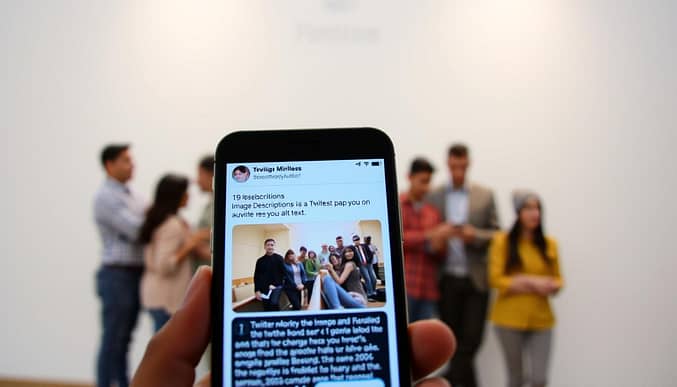How to See Alt Text on Twitter: Step-by-Step Guide
Visual descriptions play a vital role in making social media inclusive. These hidden captions, often overlooked, help screen readers convey images to users with visual impairments. Platforms like Twitter have evolved their approach to these accessibility tools, though discovering them still requires guidance.
Many users don’t realize that image descriptions exist within tweets unless they know where to look. Twitter’s interface initially made these features discreet, but recent updates like the ALT badge have improved visibility. This small icon appears on images with added descriptions, letting everyone appreciate the content fully.
Understanding these tools benefits both creators and audiences. For those using assistive technologies, clear descriptions transform visual content into meaningful context. Even casual users gain deeper engagement by viewing hidden details in shared media.
Over the years, Twitter has expanded support for inclusive features. What started as basic text options in 2016 now includes live captions and voice tweets. The platform’s dedicated accessibility team continues refining these tools, ensuring everyone can participate in digital conversations.
Key Takeaways
- Visual descriptions enhance inclusivity for users with disabilities
- Twitter’s ALT badge simplifies discovery of image captions
- Recent updates make accessibility features more visible
- Descriptions support both assistive tools and general audiences
- Platform improvements reflect growing focus on digital accessibility
Introduction: The Importance of Alt Text on Twitter
Digital communication thrives when everyone can participate equally. Alt text acts as an invisible narrator for visual content, translating pictures into words for those who can’t see them. This feature ensures social media remains inclusive, especially for people using screen readers.

What is Alt Text and Why It Matters
Alt text is a brief description embedded in images to convey their meaning. Without it, users with visual impairments miss critical context. For example, a photo of a sunset becomes “vibrant orange sky over mountains” instead of a blank space.
Technical benefits extend beyond accessibility. When images fail to load, descriptions preserve their purpose. Search engines also use alt text to index visual content, boosting discoverability. Creators who add alt text amplify their message’s reach across diverse audiences.
Overview of Twitter’s Accessibility Initiatives
Twitter introduced alt text support in 2016, but early adoption was limited. Recent updates prioritize visibility:
| Year | Feature | Impact |
|---|---|---|
| 2016 | Basic alt text field | Initial accessibility framework |
| 2020 | ALT badge for labeled images | Increased creator accountability |
| 2023 | Auto-reminders for descriptions | 25% rise in alt text usage |
The platform now encourages users to add alt descriptions through prompts during tweet composition. These efforts align with broader social media accessibility standards, fostering inclusive digital spaces. Over 40% of active people on Twitter encounter alt text daily, proving its growing significance.
Why Alt Text Matters for Accessibility on Twitter
Inclusive design transforms digital spaces into shared experiences. On Twitter, accessibility features like image descriptions ensure media-rich content reaches all audiences. These tools bridge communication gaps, whether users engage via mobile apps or desktop browsers.

Enhancing User Experience for All
Screen readers on mobile devices vocalize descriptions, while desktop users can inspect embedded text through browser tools. Both methods convert visuals into digestible information. For example, GIFs labeled with motion details become accessible narratives rather than silent loops.
| Platform | Method | Benefit |
|---|---|---|
| Mobile | Screen reader integration | Real-time audio context |
| Desktop | Inspect Element tool | Detailed text analysis |
Clear descriptions enable quick comprehension. A study by WebAIM found that 72% of screen reader users rely on accurate image labels for social media navigation. One user noted:
“Detailed captions let me participate in visual conversations I’d otherwise miss.”
While some initially struggle to locate these features, overcoming the learning curve unlocks richer interactions. Twitter’s support for multiple media formats—from infographics to animated gifs—ensures no content remains exclusionary.
How to See Alt Text on Twitter
Modern platforms embed critical features that remain invisible until activated. Twitter’s approach to alternative text demonstrates this principle, offering multiple pathways to reveal embedded descriptions.
Understanding Visual Description Mechanics
Look for the ALT badge—a small icon in images’ corners—to confirm descriptions exist. Creators can add these during tweet composition:
- Mobile: Tap “Add description” below images
- Desktop: Select “ALT” button before posting
Screen readers automatically vocalize these labels. For manual viewing:
| Platform | Method |
|---|---|
| iOS | Enable VoiceOver + double-tap image |
| Android | Activate TalkBack + explore screen |
Solving Visibility Hurdles
Missing ALT badges often mean no alternative text exists. When descriptions vanish:
- Check internet connectivity
- Update Twitter app to latest version
- Use browser extensions like Alt Text Viewer
One user shared:
“Browser tools helped me discover hidden captions others missed.”
Remember, clear text images descriptions benefit everyone. They transform complex infographics into understandable posts, making visual things accessible through words.
Viewing Alt Text on Mobile Devices
Mobile users face unique challenges when accessing visual content. While Twitter’s ALT badge helps identify labeled images, iPhones require specific tools to reveal hidden descriptions.
Using VoiceOver on iPhone
Apple’s built-in screen reader transforms visual content into spoken words. Activate VoiceOver through Settings > Accessibility > VoiceOver. For quick access:
- Enable “Triple-Click Home” in Accessibility Shortcuts
- Press the side button three times to toggle VoiceOver
When encountering images with descriptions, double-tap to hear the embedded text. One user noted:
“VoiceOver lets me enjoy memes and infographics like everyone else.”
Employing a JavaScript Bookmark in Safari
Mobile browsers lack extension support, but custom bookmarks offer workarounds. Create one using this code snippet:
javascript:(function(){[...document.images].forEach(i=>alert(i.alt))})();
Steps to implement:
- Copy the code into a new bookmark
- Name it “Show Alt Text”
- Tap the bookmark when viewing tweets
This method displays all image descriptions on the page. While less seamless than native tools, it helps when creators add description details properly.
Make sure to test both methods regularly. If descriptions don’t appear, check if the original tweet alt text exists. Mobile accessibility continues evolving, but these solutions bridge current gaps effectively.
Viewing Alt Text on Desktop Platforms
Desktop browsers offer advanced tools for accessing visual descriptions. Unlike mobile apps, these methods provide granular control over how image information appears. Three approaches dominate: screen readers, browser extensions, and custom scripts.
Screen Readers Meet Developer Tools
NVDA and JAWS screen readers pair with browser settings to reveal hidden descriptions. Try this example in Chrome:
- Right-click any Twitter photo
- Select “Inspect” from the menu
- Locate the alt attribute in HTML code
Firefox users can access similar options through Web Developer Tools. This method works for videos with static thumbnails too.
Extension Power-Ups
Add-ons like Alt Text Viewer simplify the process. After installing:
- Click the extension icon
- Hover over images
- View descriptions in pop-up boxes
| Tool | Features | Best For |
|---|---|---|
| Alt Text Viewer | Instant hover previews | Casual users |
| Accessibility Checker | Missing alt text alerts | Content creators |
CSS Customization Tricks
Advanced users implement scripts to highlight descriptions. Paste this code into browser settings:
img:after {content: attr(alt); background: #fff;}
This creates text overlays on every photo. One developer noted:
“Custom CSS makes missing descriptions obvious through bright red borders.”
Adjust options to toggle between image and text views. These methods transform desktop apps into accessibility powerhouses.
Additional Tools and Tips for Twitter Accessibility
Expanding your toolkit unlocks new levels of inclusive engagement. Beyond built-in options, third-party solutions and proactive habits ensure seamless access to visual narratives.
Tagging Alt Text Bot Accounts for Notifications
Automated services like @get_altText simplify description checks. Mention these bots in replies to receive instant transcripts:
- Type “@get_altText” in comments
- Wait for direct message with image details
- Review captions for accuracy
One user reported:
“Bots save hours I’d spend manually checking descriptions.”
Staying Updated with Twitter’s Accessibility Features
Platform updates roll out frequently. Enable notifications through:
- Profile button > Settings
- Select “Accessibility display” window
- Toggle “Feature announcements”
Recent additions like the ALT badge—a small icon marking described content—help identify accessible posts. Combine this with apps like Alt Text Checker for Chrome to audit your feed.
| Tool | Function |
|---|---|
| Accessibility Scanner | Highlights unlabeled media |
| Contrast Analyzer | Tests color readability |
Regularly review page layouts for new interactive elements. Customizable buttons in display settings let users prioritize text clarity over visual density. Pair these strategies with monthly accessibility audits to maintain an inclusive experience.
Conclusion
Accessibility innovations have reshaped how platforms connect diverse audiences over the years. Twitter’s tools for revealing image descriptions—from VoiceOver commands to browser extensions—empower users to unlock hidden context. These methods work across devices, ensuring everyone benefits from visual narratives.
Regular use of these features maintains inclusive engagement. The ALT badge and screen reader integrations have evolved through user feedback, proving that language choices in descriptions matter. Each character crafts clearer understanding for those relying on assistive technologies.
Platform updates continue refining accessibility standards. By sharing experiences through Twitter’s feedback link system, users drive meaningful improvements. For creators, following a step-by-step guide ensures media remains accessible while boosting content reach.
Every effort to implement these practices strengthens digital communities. As Twitter’s tools advance, prioritizing descriptive language remains vital. Join the movement—transform social spaces into inclusive environments where visual stories resonate with all.